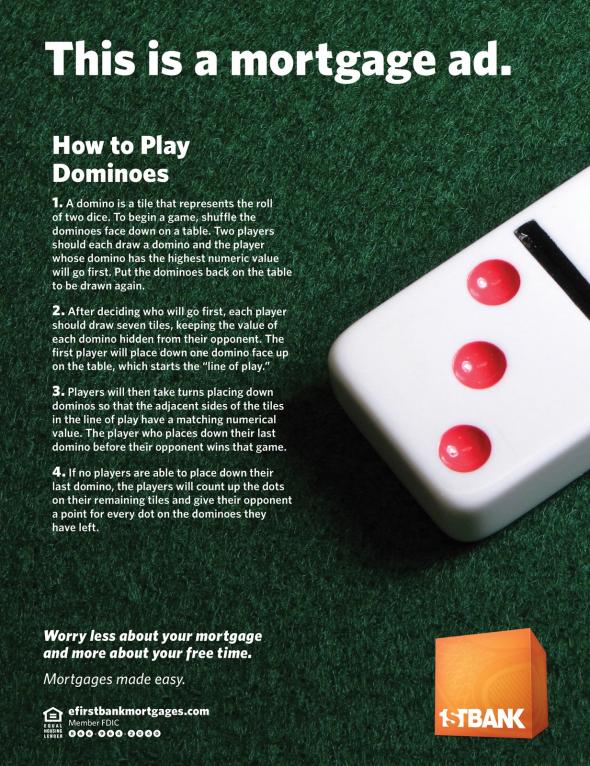Every once in a while, while thumbing through a magazine, one might stumble across an ad similar to the following:

Fig 1. FirstBank advertisement. Posted May 19, 2013. TDA_Boulder ad agency network.
Upon first glance, nothing is amiss here. However, I’d like to call into question the effectiveness of this ad. It’s much too busy, and the attempt at cleverness falls flat. The ad fails to establish strong ethos or logos, and the heavy reliance on emotional association makes the argument unbalanced. Most importantly, the advertisement fails to inform the audience what services the company actually provides.
This ad is unique and unexpected concept-wise, but it’s poorly executed. The text at the top is attention-grabbing, but the rest of the ad is not. The text in the middle– the directions on how to play dominoes– is too small and takes up too much space to keep the audience’s attention. As a general rule, advertisements should be quick and inviting, designed to catch the attention of someone who is focused on something else (flipping through a magazine or reading an online article, for example). It’s unlikely anyone distracted in this way would stay focused on an advertisement to read these large blocks of text. Perhaps the message of the ad can be received whether the text is read or not, but as a viewer, I am much less likely to stop to read this ad in the first place based on how busy it appears.
A popular technique in advertisement, this ad attempts to transfer the positive association with games and having free time to the FirstBank company. It states you can “worry less about your mortgage and more about your free time.” This has the potential to be a good slogan. However, with little information on the specifics of the company or what they actually do, it can be difficult to understand how accurate this claim of “mortgages made easy” actually is. By failing to establish the credibility of the company, this ad fails to establish ethos. Additionally, it fails to provide data or statistics on the success of the company in the past, which could’ve strengthened the logos of the add. Although the argument that easier mortgages lead to more free time is a logical conclusion, this appeal is based more on pathos than anything else, since it relies heavily on how we associate this company with free time, making it seem more positive.
I touched on this briefly above, but my largest qualm with this ad is that I hardly know anything about the company. What services do they actually provide besides “making mortgages easy”? How successful has this company been in the past? Are consumers generally satisfied with the services they are provided? What does this company value, and do these values align with my personal values as a consumer? These are the types of questions which are typically answered in an advertisement. While this concept is clever, it isn’t effective if consumers don’t understand what is actually being advertised.
This ad misses the mark every step of the way. It’s too busy, which means it fails to grab the audience’s attention. The argument established by the ad is flimsy at best, based heaviest on only one of three rhetorical appeals. The cute and fun concept of the ad actually detracts from the point of the ad itself. Finally, the questions of consumers whose attention might have been grabbed, despite all these negatives, are left unanswered by this unsatisfying ad.
0 Comments